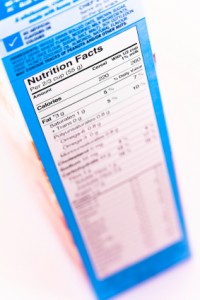**This post is part of the Get Real series. Please remember that this is meant as a learning community. We know that many of you are passionate about what you do and we want you to express that, just please do so in a way that will be an encouragement and aid to others making a transition. We want this to be a “safe space” for participants to learn. For that reason, we reserve the right to delete any comments that are not handled in this manner.
The following is a guest post by Lisa Leake of 100 Days of Real Food. (This was originally published in Jan 2012 but has recently been republished and updated).
I am super excited to help kick off the Once a Month Meals “Get Real” Series! This is the perfect time of year to start fresh, and whether you want to dive in headfirst or very slowly cut out processed food one step at a time, then this introductory post is for you.
After reading Michael Pollan’s book In Defense of Food, watching the documentary Food, Inc., spending hundreds of hours on research, and actually practicing what I preach (including my family’s “100 Days of Real Food” pledge) this is how I define “real food”…
What is “real food”? It is:
- Whole foods that typically only have 1-ingredient like “brown rice” or that have no ingredients…like fruits and vegetables!
- Packaged food that’s made with 5 or fewer unrefined ingredients
- Dairy products like whole milk, unsweetened yogurt, eggs, and cheese
- Bread and crackers that are 100% whole-grain
- Wild-caught seafood
- Locally and humanely raised meat like chicken, pork, beef, and lamb
- Dried fruits, nuts, and seeds
- Naturally made sweeteners, which include honey and maple syrup
- More a product of nature than a product of industry
Real food is NOT:
- Labeled as “low fat” or “low carb” or “low calorie” (in most cases)
- Made with refined or artificial sweeteners (like sugar or Splenda)
- Deep-fried in refined oils
- 100-calorie packs or any foods made from refined grains like white flour (which is often labeled as “wheat flour”)
- In packages with loads of ingredients, some of which you cannot even pronounce
- Highly processed foods that are labeled as organic (like organic cheddar crackers, organic cookies, or organic candy – sorry!)
- From a drive-through window or gas station
Where to Begin
When making the transition to “real food” the best place to begin is in your own pantry, fridge, and freezer. And the best advice I could ever give anyone is to start by reading the ingredient labels on everything you own. Before our switch to “real food” I used to pay attention to product health claims on the front of food packages (like “low-fat” or “lower your cholesterol”), and I occasionally looked at the back to check things like fat grams, calories, and carbs.
I have no idea why, but until I read Michael Pollan’s book it never occurred to me to read the ingredients to find out what they actually used to make our food. And once I started investigating, what I found were very long lists including ingredients I couldn’t even pronounce (nor would I cook with in my own home). It was definitely a very big wake-up call.
The best way to find out if a packaged food is highly processed is to read the ingredients.
The Good List:
 Products with no more than 5 ingredients
Products with no more than 5 ingredients- Whole grains including brown rice, whole-wheat, quinoa, and oats
- Ingredients you can pronounce and that you would cook with on your own
- Whole milk dairy products including milk, cheese, and yogurt
What to Avoid:
- “Wheat” because that is a refined grain (a.k.a. white flour) unless it says the word “whole” along with the word “wheat”
- “Rice” because unless it says “brown rice” once again it’s a refined grain
- Sweeteners (including sugar, brown rice syrup, cane juice, corn syrup, maple syrup, and honey) listed in the top 3 ingredients
- Any artificial ingredients including food coloring and sweeteners
Before I cleaned out my kitchen I used to buy things like graham crackers, boxed macaroni and cheese, white sandwich bread, conventional skim milk, boxed cereal, canned condensed soup, and the occasional frozen pizza. I honestly lost sleep over what I would feed my husband and children (ages 3 and 5 at the time) if I could no longer rely on these processed foods. But after a lot of trial and error, I eventually found our “new normal.” The initial transition was not easy, but I knew it was the right thing to do if I no longer wanted to compromise the health of my family.
Today, some foods you’ll find in my kitchen:
- Plain oats (for making oatmeal) and homemade granola cereal
- A wide variety of nuts
- Whole milk and lots of cheese
- Organic fruits & veggies
- Whole-grain crackers including Ak-Mak, Multiseed & Triscuits
- Brown rice and whole-grain flours (for making homemade bread, muffins & tortillas)
- Dried and canned beans
- Store-bought whole-wheat pasta
- Dried fruit like raisins
- Popcorn
- Unrefined cooking oils like olive oil, coconut oil, and ghee
- Frozen locally raised meats
For a more complete look, be sure to check out my list of “21 Real Food Essentials for Freezer, Pantry & Fridge.” I also created a “Supermarket Real Food Cheat Sheet,” which details every single item in my local grocery store that follows our real food rules. And since some people just like it when you tell them exactly what to do be sure to download our “Real Food Meal Plans,” which are 7-day family meal plans (including breakfast, lunch, snack, and dinner) with accompanying grocery lists and pricing.
Transitioning from highly processed food to “real food” can be a big transformation and is not to be tackled overnight. No matter how quickly or slowly you decide to start making changes for your family, I think it’s important to remember that this doesn’t have to be an all-or-nothing commitment. Even the smallest changes, like simply switching to a “real” 5-ingredient whole-wheat bread, for example, could make a big impact. And any changes you start to make will only get easier and become your “new normal” over time.
Key Takeaway: Read AND scrutinize ingredient labels!
Other Essential Resources
- Breaking Down Common Misconceptions (including “mutli-grain,” “natural,” and “low-fat”)
- Understanding Grains
- 10 Reasons to Cut out Processed Food
- 14 Steps to Cutting our Processed Food
- Take the “10 Days of Real Food Pledge“
- Listing of Real Food Meal Ideas and Recipes
- Tips for Dealing with Picky Eaters
- Convincing a Reluctant Spouse to Eat Real Food
- In Defense of Food by Michael Pollan
- The documentary Food, Inc.
 Lisa Leake is a wife, mother, foodie, and blogger who chronicles her family’s journey on 100 Days of Real Food as they seek out the real food in our processed food world. Leake’s award-winning blog is receiving national attention from big names like Rachael Ray, Jamie Oliver, and Yahoo! and has also been turned into a nationally-syndicated newspaper column.
Lisa Leake is a wife, mother, foodie, and blogger who chronicles her family’s journey on 100 Days of Real Food as they seek out the real food in our processed food world. Leake’s award-winning blog is receiving national attention from big names like Rachael Ray, Jamie Oliver, and Yahoo! and has also been turned into a nationally-syndicated newspaper column.
